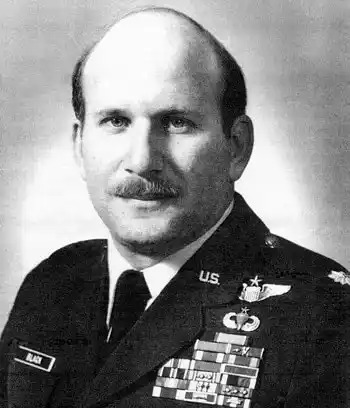Sharing stories from history is part of why I so enjoy being a staff member of the History Center. Researching and writing about people and events from the past is interesting to me. One recent opportunity to research military history reminded me that sometimes the most extraordinary stories can come from the most unlikely places.
In 1970, a student-led organization called Voices in Vital America introduced POW/MIA bracelets to ensure that service members who were prisoners of war or missing in action in Vietnam not be forgotten. Each bracelet, made of nickel or copper, contained the service member’s name and date of capture or disappearance and would be worn until he returned home. It was just such a bracelet that I had the chance to investigate early last month after taking a phone call at the History Center from a gentleman in Florida.
Retired Marine Kermit McNeal was seeking answers to questions he had about a POW/MIA bracelet that he bought approximately two years prior while visiting a flea market. He wanted to know if the person named on the bracelet – Arthur Black - had survived the war, and if Black or his family would like to have the bracelet. Unfortunately, Mr. McNeal’s efforts to learn about the bracelet had been futile. “No one wanted to help me,” he said. After receiving no assistance from some other history organizations, he found the Bossier Parish History Center online and reached out.
His reasons for buying the bracelet were both noble and personal. As a Vietnam veteran, he thought it “undignified” to leave the bracelet behind. “I simply couldn’t walk away and leave it there,” he told me. But an incident on the home-front during the war also played a role in his decision. During his time of service, someone attempted to swindle money from his mother by claiming that he had been captured, and saying they could affect his release for a fee. Thankfully, the ruse didn’t succeed. “I was never captured, but just hadn’t written home in a while,” he said. “This bracelet represented someone who had been captured or was missing.”
The History Center is privileged to have a POW/MIA bracelet in its archive collection. It bears the name William Butler, an Air Force pilot who spent nearly 6 years as a prisoner after being shot down over North Vietnam in 1967. In a column published a year ago, History Center Public Historian Pam Carlisle shared how his bracelet impacted the lives of a Bossier City couple by creating an opportunity to learn his story. Similarly, the bracelet purchased by Mr. McNeal would open an avenue for him to learn Arthur Black’s story.
As I began researching Mr. Black and the date of September 20, 1965 shown on his bracelet, I was surprised by the amount of information available. He served as an Air Force pararescueman, sometimes called a PJ (for parajumper). His job was extremely dangerous. The National Museum of the United States Air Force describes it this way: “The PJ's unique mission in Vietnam was to ride into a combat zone aboard a slow, vulnerable helicopter, and descend into jungles, swamps, mountains and forests on a cable and winch. On the ground, they stabilized and helped hoist the injured to safety, often under fire.”
According to the museum’s website, pararescueman wore flight crew helmets and armored “flak” jackets for protection and carried weapons such as .38-caliber pistols, M-16 rifles and survival knives. Basic medical kits were used to tend the wounded. The website states that because of the heroic work done by Black and other PJs in Vietnam, more than 4,000 lives were saved.
It was while attempting to recover a pilot whose plane had gone down that Black’s helicopter crashed after being fired upon by enemy troops. He and three others aboard were immediately captured, beginning nearly eight years of beatings, torture and other abuse. In a recent interview with the Times of San Diego newspaper, he talked about how the ordeal caused him to review his life. “I thought about the past, all the things that I had done good and bad. I considered … what my parents were going through. And I figure they were having a harder time than me.”
After 2,703 days in captivity, Mr. Black came home. Released in 1973, he received a presidential commission to second lieutenant and continued his Air Force career by becoming a pilot himself and retired with the rank of major in 1987. He resides in Carlsbad, California, and thanks to the assistance of Carlsbad Mayor Keith Blackburn, I was able to contact Mr. Black and share with him how Kermit McNeal had discovered his bracelet. Honored to learn of this and grateful that McNeal hadn’t left it behind, Black said he was welcome to keep it.
That a flea market find could lead to uncovering such stories amazed me. That it offered the chance to interact with these two veterans was a privilege. Mr. McNeal thanked me for my efforts, saying he was certainly happy to hear that Black survived the war, and said the bracelet would remain on display in his home. Opportunities like this make working at the History Center so appealing. I may never look at flea markets the same way again.
If you have any information or items relating to the history of Bossier Parish, the History Center may be interested in adding the materials to its research collection by donation or by scanning them and returning the originals. Call or visit us to learn more. We are open M-Th 9-8, Fri 9-6, and Sat 9-5. Our phone number is (318) 746-7717 and our email is history-center@bossierlibrary.org. We can also be found online at https://www.facebook.com/BPLHistoryCenter/ and http://bpl-hc.blogspot.com/
Images:
- Arthur Black/photo courtesy U.S. Air Force
- William Butler's POW/MIA bracelet/History Center collection
- Arthur Black as a pararescueman/photo courtesy Arthur Black



No comments:
Post a Comment